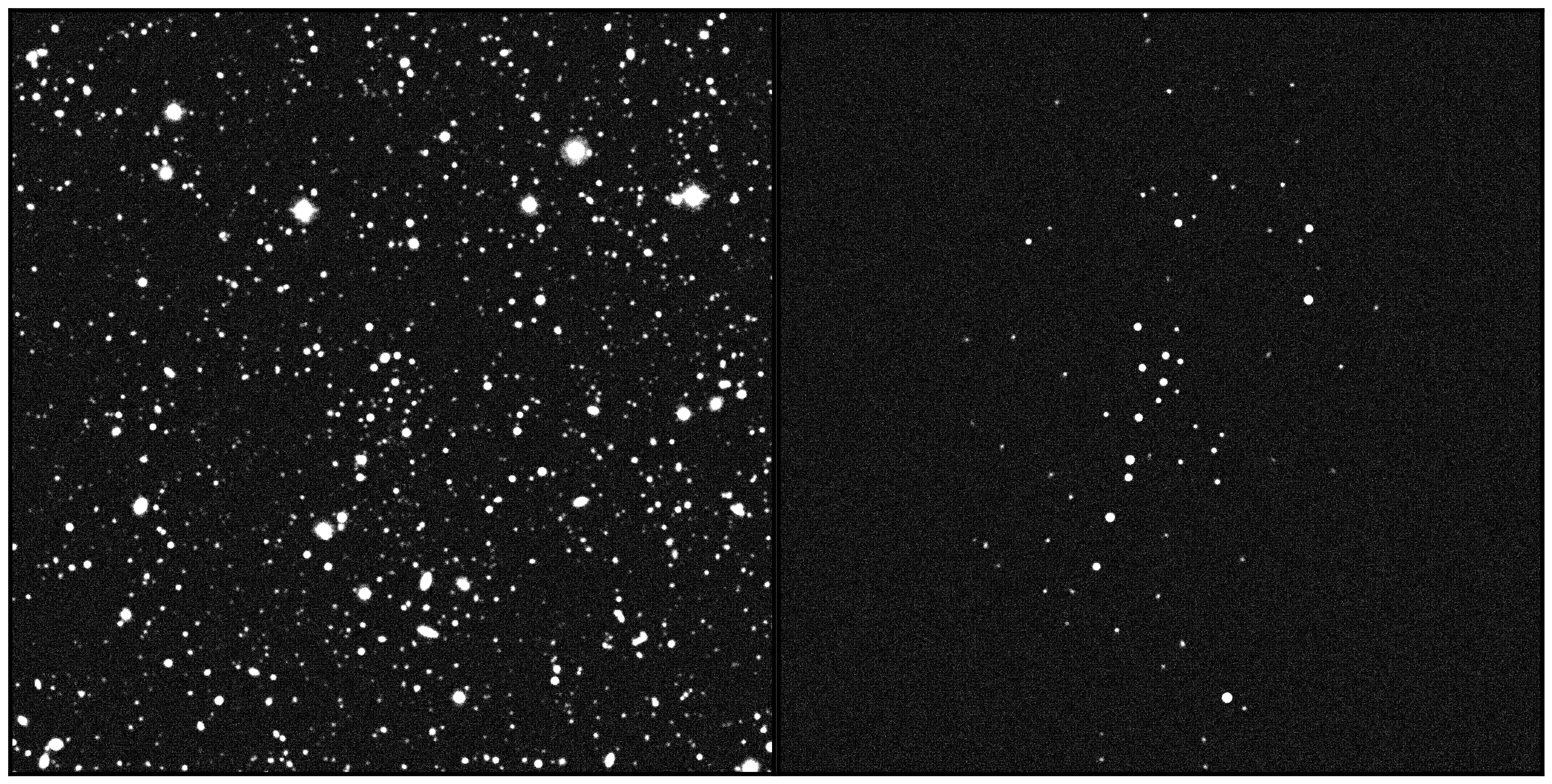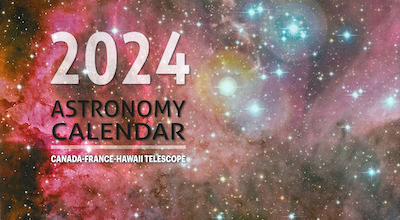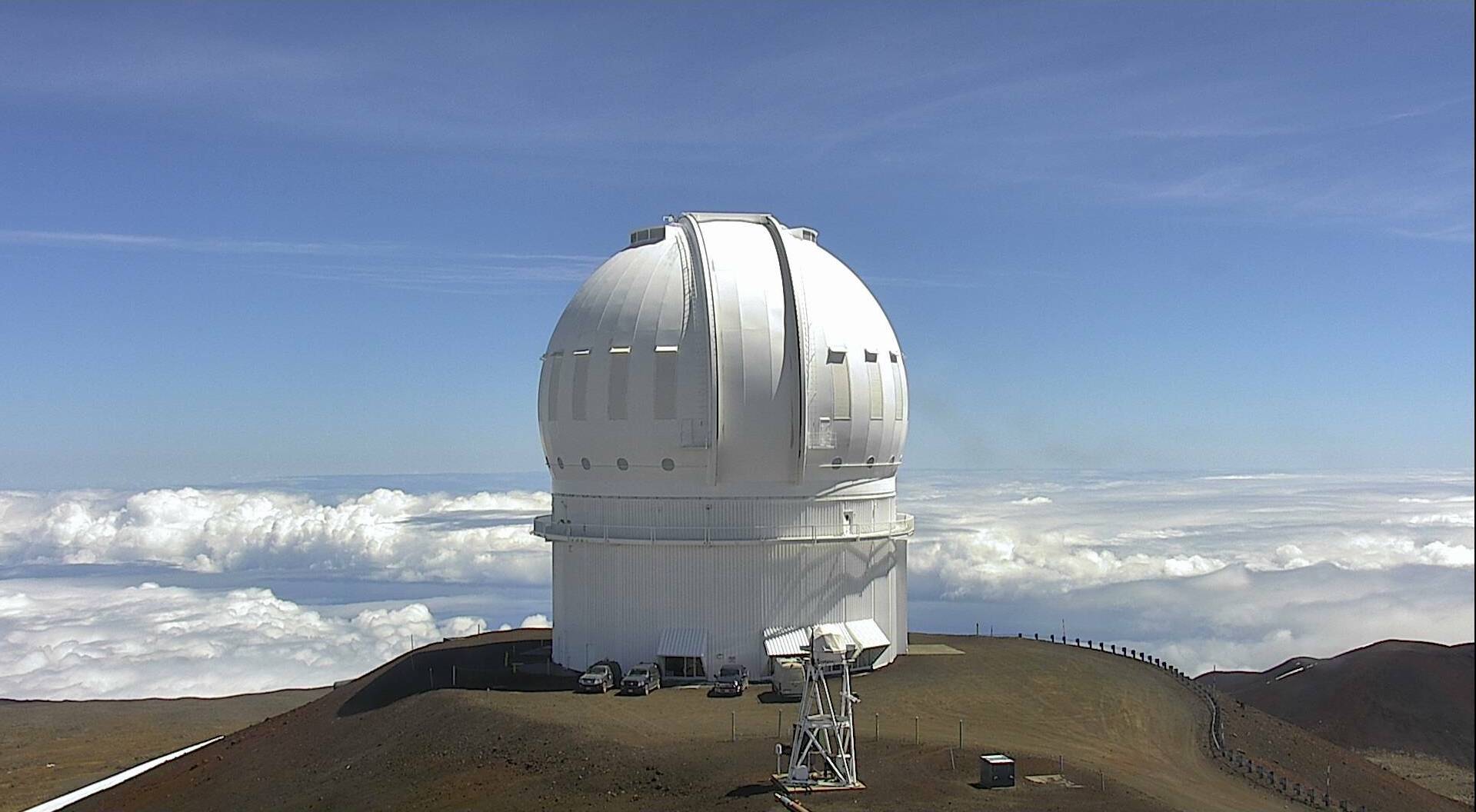Weak Gravitational Lensing Reveals Dark Matter Maps of the Cosmic Web
Scientists at CEA Saclay (Commissariat à l’énergie atomique et aux énergies alternatives) in France used data from the international science collaboration UNIONS (Ultraviolet Near Infrared Optical Northern Survey) to generate a reference catalog of 100 million gravitationally lensed distant galaxies, one of the largest datasets ever created. The new catalog is based on thousands of deep images of the northern sky captured by MegaCam, a large digital camera built at CEA, mounted on the Canada-France-Hawaii Telescope (CFHT). Three new publications present dark-matter mass maps of the cosmic web, showing how the high-density regions in these maps help measure the still poorly known properties of dark matter.
A new milestone has been reached for weak gravitational lensing with the release of one of the largest galaxy catalogs to date. This catalog contains precisely measured shapes of 100 million galaxies, which trace the slight deformations caused by the gravitational lensing of light traveling throughout the cosmic web of dark matter that permeates the Universe. Modern cosmology requires careful handling of the error budget and comparing catalogs produced through complementary approaches is part of the process. Two versions of the shape catalog, obtained with different, independent methods, have just been released internally to the Ultraviolet Near Infrared Optical Northern Survey (UNIONS) science collaboration. UNIONS is a large imaging survey of the northern sky in the optical and near-infrared, co-led by Jean-Charles Cuillandre CEA Saclay/Université Paris-Saclay. Three telescopes based in Hawai’i are used to conduct this ambitious survey started in 2017: the Canada-France-Hawaii Telescope (CFHT), Pan-STARRS of the University of Hawai’i, and the Japanese Subaru telescope.
The key cosmology observations were captured at CFHT with the wide-field imaging camera MegaCam, built by CEA twenty years ago. MegaCam with its one square degree field of view (four times the size of the full Moon) and 375 million pixels was the largest optical astronomical camera in the world when it saw its first light. Since then it has been surpassed by only four other wide-field cameras (three of which are engaged in UNIONS) and remains at the forefront of science. The scientists who produced this new catalog are now inviting all UNIONS members to utalize this dataset to conduct new science projects.
UNIONS expands upon the Canada-France Imaging Survey (CFIS), a large program at CFHT. Starting in 2017, CFIS utilized 346 nights of observation time with the goal of addressing some of the most fundamental questions in astronomy: the properties of dark matter and dark energy, how the galaxy cluster structure seen in the Universe today grew from galaxies and how the Milky Way assembled.
“The superb observing conditions at CFHT on Maunakea lead to the unprecedented collection of galaxies over a very large area of the sky culminating in this truly unique catalog” said Cuillandre. “MegaCam’s sensitivity in the blue end of the spectra and CFHT's outsdanding delivered image quality in the optical play a critical role in UNION’s goal to survey the northern sky in those wavelengths.”
Under the lead of Martin Kilbinger, one of the two catalog versions was created over a four-year period by the CosmoStat laboratory (CEA/IRFU/DAp). To process UNIONS data from CFHT, an entire processing pipeline was developed, called ShapePipe. ShapePipe has so far processed a total area sky area of 3,500 square degrees, using more than a million CPU hours and producing 500 terabytes of data; the final weak-lensing data containing 100 million galaxies has a size of 18 gigabytes. The software is modular and has high-performance computation capabilities. It combines state-of-the-art third-party methods with in-house methods developed by CosmoStat. Due to its modular architecture, it is easy to test and implement new algorithms, and can be applied to other weak-lensing surveys. A technical article led by Samuel Farrens, detailing the software, has been submitted to the peer-reviewed Astronomy & Astrophysics journal. CosmoStat has made the code public.
Two science projects led by CosmoStat members and alumni, under the supervision of Kilbinger, using UNIONS weak-lensing data have been published. First, Guinot et al. (A&A article in press) carry out careful testing and validation of the ShapePipe catalogs, and present dark-matter maps and mass profiles of galaxy clusters observed by the ESA satellite mission Planck. This demonstrates the very high quality of UNIONS lensing data, at par or even better than other large surveys such as the KIlo Degree Survey (KiDS) or the Dark Energy Survey (DES), while the sky coverage of UNIONS is still only partial (goal: 5 000 square degrees)
As a second astrophysical application,Ayçoberry et al. (submitted to A&A) examine weak-lensing peak counts as a method to measure cosmological parameters. These peaks trace high-density regions in the cosmic web, the properties of which are very sensitive to the underlying cosmological model. The publication introduced a novel method to explore spatial variations of the lensing calibration, and assesses a variety of uncertainties and systematics that can impact cosmological inference.
In the near future the UNIONS observations will provide essential support to the European space telescope Euclid. This ESA satellite mission will map the cosmic web over the entire accessible sky at an unprecedented resolution to measure the properties of the mysterious dark energy.
“UNIONS’ unique collaboration and observing strategy made the development of this new catalog possible,” said Todd Burdullis, QSO Observations Specialist at CFHT. “MegaCam’s efficiency in completing large programs like UNIONS continues to create legacy catalogs and archival data, expanding our understanding of the universe.”
Additional links
Guinot et al.
Ayçoberry et al.
Media Contacts
Mary Beth Laychak
Director of Strategic Communications, Canada-France-Hawai'i Telescope
808-885-3121
laychak@cfht.hawaii.edu
Scientific Contacts
Martin Kilbinger
Science lead, data processing
martin.kilblinger@cea.fr
Jean-Charles Cuillandre
French lead of the UNIONS science collaboration
jc.cuillandre@cea.fr






